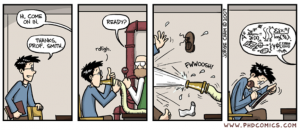In 2013 I’m celebrating a notable personal milestone – it’s been ten years since I entered the world of elearning. In that time I’ve seen many things change (where do I start?) but sadly some things stay the same, and the L&D department is often one of them.
In a previous post I mentioned the Corporate Leadership Council’s L&D Team Capabilities Survey, which Charles Jennings had referred to at the 2012 Learning Technologies Conference.
According to the survey, when asked if they would recommend working with L&D, barely 14% of corporate leaders said yes, they would actively do so. Of the remainder, 34% had no strong opinion and just over half would actually recommend not working with L&D.
And they’ve given us the reason why; the same report states that less than a quarter of line management were satisfied with L&D’s impact on achieving business outcomes.
Stop reading for a moment and let that sink in.
More than half of the manager’s surveyed would recommend not working with L&D and over three quarters were dissatisfied with L&D’s impact on business outcomes.
The root of this is a lack of ownership on the part of L&D. This isn’t about ownership for designing and delivering a piece of training, or of creating a good piece of content and giving a good experience. It’s about sharing in the ownership and responsibility for delivering actual performance results.
Real Partners
How do we do that? For a start, we act as partners.
I do need to qualify this; I’m not talking about a change of job title, I’m talking about a change of behaviour. There are plenty of people who have gone from being a Training Manager to an L&D Managers to an L&D Business Partner without any significant change to the role they play.
This is about real partnership, and real partners;
* Are equal in their status
* Involved in the decision making process
* Aligned to the organisational plan
Again, this isn’t about job titles. No one needs to give you permission to start acting like a partner instead of an order taker (and let’s be clear, that’s the choice). Do you want to be an order taker forever? Being a partner is hard work. It certainly takes more effort than being an order taker and it’s more risky because it requires you to take on your share of responsibility for the success or failure of the business.
As L&D specialists, everything we do should be working towards achieving the organisation’s goals. When someone comes to talk to us about a perceived learning need, it’s those business terms that we should be discussing their requirements;
- How does this align with the organisation’s goals?
- What are the specific measurable goals in doing this?
- What will people do differently as a result of this? (Not know, but do)
- How will things be improved by doing this? (What are the results we expect to see that will tell us if we have succeeded?)
It’s important that people understand what we do, and what we could do – the potential benefits that we can bring to the organisation. We can only do this if we can talk credibly to the rest of the organisation in terms of achieving their goals, not ours. We must be talking about organisational results and not courses run or modules completed.
Of course, we also need to understand what our customers need and want, but that doesn’t mean coming away with a shopping list of functionality in an LMS or a list of courses to deliver – it means getting a real understanding of what they are trying to achieve, so that you (as the learning expert) can offer solutions.
The better you understand what they need to achieve, the better you understand how you can help them, and long term the greater the chance you have of getting their support,
Build Alliances
Partnership is a two way thing, and it isn’t something that just happens at the point someone has a particular training need. We should be proactively building alliances.
Ask yourself;
- Who can I build alliances with?
- Who can help me identify the ways in which L&D can demonstrate more business focus?
- Who can help me to demonstrate our business focussed approach?
- Who would benefit from the support of a truly business focussed ally within L&D?
There may be some obvious candidates; line managers who you regularly work with, colleagues in IT, senior HR stakeholders, but don’t limit yourself. Look for anyone in the organisation where it would make sense to develop a real solid relationship; People with whom you can align your short, mid and long term goals and share resources.
Influence the Influencers
One of the greatest benefits of forming the right alliances is that we are better able to influence organisational decision making. If you want to establish a really effective L&D department, it doesn’t do any harm to get somebody senior on board as a cheerleader. Especially if we’re starting from the kind of position that the Corporate Leadership Council survey suggests that we might be.
Perhaps it’s obvious, but if you can’t directly influence the decision makers, then try and influence those people that can influence the decision makers. Use those alliances!
There is one other aspect of ownership that we need to cover, and maybe I’m being a little tough, but it’s tough love I promise you!
Stop Making Excuses
We really have to stop making excuses. In my ten years I’ve heard the same excuses trotted out, whether the subject was LMS, elearning content, social learning or using mobile devices.
- It won’t work here
- It won’t work with our people
- IT says we can’t do it
If we’re going to take ownership for results, this just isn’t going to cut it. At the very least we need to make reasoned arguments why these things are or aren’t true.
Let’s just consider the last point; IT says we can’t do it. It’s a pretty common thing to hear, but if you just accept no for an answer, you become the single point of failure. So what do you do?
If we want be a partner, we should be able to develop a mature relationships with IT, one in which we partner with them, but aren’t dependent on them. Even then, it may be that they say no, and for perfectly good reasons, so what else can we do?
We explore the possibilities;
Are there external relationships that can offer us a solution? Do we have suppliers who can do what we need without the requirement for support from IT?
What about the tools you do have? Can you adapt something you already have to do what you need, or at least get close to it?
Or is there an alternative that IT will support. It may not be exactly the same solution but if it gets you closer to the result than you were before, it’s a winner.
Remember we’re also building alliances, so look for mutually beneficial solutions. If you want to install social enterprise platform ‘X’ and IT say no, but you know they really want to build something with collaboration platform ‘Y’, don’t treat it as second best, get on board and find a way to use that and support their goal too.
Clearly, what I’ve said doesn’t apply to everyone in L&D, but be honest with yourself; does any of this sound familiar? If so, it’s not too late to change.






